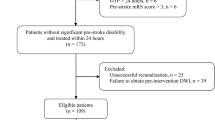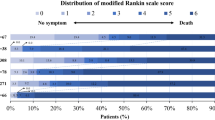Abstract
Poor clinical outcomes despite endovascular therapy (EVT) are common in patients with acute basilar artery occlusion (BAO). We aimed to develop a new angiographic collateral grading system for predicting 90-day functional outcomes of acute BAO after EVT. A prospectively registered consecutive cohort of acute BAO patients treated with EVT in our center during a 6-year period was reviewed. The angiographic collateral grading system for BAO (ACGS-BAO) included 4 grades for poor (grade 1–2), intermediate (grade 3), and good (grade 4) collateral statuses. First, the independent association of ACGS-BAO with 90-day functional independence (mRS ≤ 2), favorable outcome (mRS ≤ 3), and death was evaluated by multivariable logistic regression model; then, the heterogeneity in the effects of ACGS-BAO on 90-day outcomes was explored among the subgroups stratified by age, time window, stroke severity, and etiology. Finally, the interobserver agreement of ACGS-BAO was assessed by weighted kappa statistic. Of 173 patients included in this study, 62 (35.8%), 83 (48.0%), and 36 (20.8%) achieved 90-day functional independence, favorable outcome, and death, respectively. Multivariable logistic analyses showed that ACGS-BAO was independently associated with functional independence (OR = 2.07, 95% CI = 1.05–4.07) and favorable outcome (OR = 1.84, 95% CI = 1.02–3.43) but not related to death (OR = 0.78, 95% CI = 0.37–1.64). Similar effects of ACGS-BAO on 90-day outcomes were seen across all subgroups (P > 0.10 for all interactions). The interobserver agreement of ACGS-BAO was very high (weighted kappa = 0.96, 95% CI = 0.93–0.99). The ACGS-BAO is an angiographic tool with excellent interobserver reliability that can be used to predict the 90-day outcome of acute BAO treated by EVT. Nevertheless, our findings are still needed to be confirmed in a prospective multicenter study before clinical application.




Similar content being viewed by others
References
Singer OC, Berkefeld J, Nolte CH, Bohner G, Haring HP, Trenkler J, et al. Mechanical recanalization in basilar artery occlusion: the ENDOSTROKE study. Ann Neurol. 2015;77(3):415–24. https://doi.org/10.1002/ana.24336.
Kang DH, Jung C, Yoon W, Kim SK, Baek BH, Kim JT, et al. Endovascular thrombectomy for acute basilar artery occlusion: a multicenter retrospective observational study. J Am Heart Assoc. 2018;7(14). https://doi.org/10.1161/JAHA.118.009419.
Writing Group for the BASILAR Group, Zi W, Qiu Z, Wu D, Li F, Liu H, et al. Assessment of endovascular treatment for acute basilar artery occlusion via a nationwide prospective registry. JAMA Neurol. 2020;77(5):561–73. https://doi.org/10.1001/jamaneurol.2020.0156.
Phan K, Phan S, Huo YR, Jia F, Mortimer A. Outcomes of endovascular treatment of basilar artery occlusion in the stent retriever era: a systematic review and meta-analysis. J Neurointerv Surg. 2016;8(11):1107–15. https://doi.org/10.1136/neurintsurg-2015-012089.
Liu X, Dai Q, Ye R, Zi W, Liu Y, Wang H, et al. Endovascular treatment versus standard medical treatment for vertebrobasilar artery occlusion (BEST): an open-label, randomised controlled trial. Lancet Neurol. 2020;19(2):115–22. https://doi.org/10.1016/S1474-4422(19)30395-3.
Kayan Y, Meyers PM, Prestigiacomo CJ, Kan P, Fraser JF, Society of NeuroInterventional Surgery. Current endovascular strategies for posterior circulation large vessel occlusion stroke: report of the Society of NeuroInterventional Surgery Standards and Guidelines Committee. J Neurointerv Surg. 2019;11(10):1055–62. https://doi.org/10.1136/neurintsurg-2019-014873.
Garg R, Biller J. Neuroimaging predictors of clinical outcome in acute basilar artery occlusion. Front Neurol. 2017;8:293. https://doi.org/10.3389/fneur.2017.00293.
Mattle HP, Arnold M, Lindsberg PJ, Schonewille WJ, Schroth G. Basilar artery occlusion. Lancet Neurol. 2011;10(11):1002–14. https://doi.org/10.1016/S1474-4422(11)70229-0.
Goyal N, Tsivgoulis G, Nickele C, Doss VT, Hoit D, Alexandrov AV, et al. Posterior circulation CT angiography collaterals predict outcome of endovascular acute ischemic stroke therapy for basilar artery occlusion. J Neurointerv Surg. 2016;8(8):783–6. https://doi.org/10.1136/neurintsurg-2015-011883.
van der Hoeven EJ, McVerry F, Vos JA, Algra A, Puetz V, Kappelle LJ, et al. Collateral flow predicts outcome after basilar artery occlusion: the posterior circulation collateral score. Int J Stroke. 2016;11(7):768–75. https://doi.org/10.1177/1747493016641951.
Da Ros V, Meschini A, Gandini R, Del Giudice C, Garaci F, Stanzione P, et al. Proposal for a vascular computed tomography-based grading system in posterior circulation stroke: a single-center experience. J Stroke Cerebrovasc Dis. 2016;25(2):368–77. https://doi.org/10.1016/j.jstrokecerebrovasdis.2015.10.008.
Alemseged F, Shah DG, Diomedi M, Sallustio F, Bivard A, Sharma G, et al. The basilar artery on computed tomography angiography prognostic score for basilar artery occlusion. Stroke. 2017;48(3):631–7. https://doi.org/10.1161/STROKEAHA.116.015492.
Menon BK, d’Esterre CD, Qazi EM, Almekhlafi M, Hahn L, Demchuk AM, et al. Multiphase CT angiography: a new tool for the imaging triage of patients with acute ischemic stroke. Radiology. 2015;275(2):510–20. https://doi.org/10.1148/radiol.15142256.
Ben Hassen W, Malley C, Boulouis G, Clarençon F, Bartolini B, Bourcier R, et al. Inter- and intraobserver reliability for angiographic leptomeningeal collateral flow assessment by the American Society of Interventional and Therapeutic Neuroradiology/Society of Interventional Radiology (ASITN/SIR) scale. J Neurointerv Surg. 2019;11(4):338–41. https://doi.org/10.1136/neurintsurg-2018-014185.
Bamford J, Sandercock P, Dennis M, Burn J, Warlow C. Classification and natural history of clinically identifiable subtypes of cerebral infarction. Lancet. 1991;337(8756):1521–6. https://doi.org/10.1016/0140-6736(91)93206-o.
Jauch EC, Saver JL, Adams HP Jr, Bruno A, Connors JJ, Demaerschalk BM, et al. Guidelines for the early management of patients with acute ischemic stroke: a guideline for healthcare professionals from the American Heart Association/American Stroke Association. Stroke. 2013;44(3):870–947. https://doi.org/10.1161/STR.0b013e318284056a.
Powers WJ, Derdeyn CP, Biller J, Coffey CS, Hoh BL, Jauch EC, et al. 2015 American Heart Association/American Stroke Association focused update of the 2013 guidelines for the early management of patients with acute ischemic stroke regarding endovascular treatment: a guideline for healthcare professionals from the American Heart Association/American Stroke Association. Stroke. 2015;46(10):3020–35. https://doi.org/10.1161/STR.0000000000000074.
Powers WJ, Rabinstein AA, Ackerson T, Adeoye OM, Bambakidis NC, Becker K, et al. 2018 guidelines for the early management of patients with acute ischemic stroke: a guideline for healthcare professionals from the American Heart Association/American Stroke Association. Stroke. 2018;49(3):e46–46e110. https://doi.org/10.1161/STR.0000000000000158.
Schonewille WJ, Wijman CA, Michel P, Rueckert CM, Weimar C, Mattle HP, et al. Treatment and outcomes of acute basilar artery occlusion in the Basilar Artery International Cooperation Study (BASICS): a prospective registry study. Lancet Neurol. 2009;8(8):724–30. https://doi.org/10.1016/S1474-4422(09)70173-5.
Zaidat OO, Yoo AJ, Khatri P, Tomsick TA, von Kummer R, Saver JL, et al. Recommendations on angiographic revascularization grading standards for acute ischemic stroke: a consensus statement. Stroke. 2013;44(9):2650–63. https://doi.org/10.1161/STROKEAHA.113.001972.
Hacke W, Kaste M, Bluhmki E, Brozman M, Dávalos A, Guidetti D, et al. Thrombolysis with alteplase 3 to 4.5 hours after acute ischemic stroke. N Engl J Med. 2008;359(13):1317–29. https://doi.org/10.1056/NEJMoa0804656.
Yoon W, Kim SK, Heo TW, Baek BH, Lee YY, Kang HK. Predictors of good outcome after stent-retriever thrombectomy in acute basilar artery occlusion. Stroke. 2015;46(10):2972–5. https://doi.org/10.1161/STROKEAHA.115.010840.
Mourand I, Machi P, Nogué E, Arquizan C, Costalat V, Picot MC, et al. Diffusion-weighted imaging score of the brain stem: a predictor of outcome in acute basilar artery occlusion treated with the Solitaire FR device. AJNR Am J Neuroradiol. 2014;35(6):1117–23. https://doi.org/10.3174/ajnr.A3870.
Bouslama M, Haussen DC, Aghaebrahim A, Grossberg JA, Walker G, Rangaraju S, et al. Predictors of good outcome after endovascular therapy for vertebrobasilar occlusion stroke. Stroke. 2017;48(12):3252–7. https://doi.org/10.1161/STROKEAHA.117.018270.
Kwak HS, Park JS. Mechanical thrombectomy in basilar artery occlusion: clinical outcomes related to posterior circulation collateral score. Stroke. 2020;51(7):2045–50. https://doi.org/10.1161/STROKEAHA.120.029861.
Acknowledgments
We would like to thank patients, clinical staff, imaging, and laboratory technicians for their contribution to this study. We also would like to thank Dr. WaiTing Joyce Lo (Department of Medicine, Queen Elizabeth Hospital, Hong Kong, China) and Dr. Trilochan Srivastava (Department of Neurology, SMS Medical College, Jaipur, India) for their generous input on language editing.
Funding
This study was funded by the Beijing Municipal Science & Technology Commission (No. Z18110000171837), China Postdoctoral Science Foundation (No. 2019M650773), National Key Research and Development Program of China (No. 2016YFC1301500), and Hebei Provincial Health and Family Planning Commission (No. 20181258).
Author information
Authors and Affiliations
Corresponding authors
Ethics declarations
Conflict of Interest
The authors declare that they have no conflicts of interest.
Research Involving Human Participants and/or Animals
The study procedures were in accordance with the 1964 Helsinki declaration and its later amendments. Informed consent was obtained from all individual participants included in the study. The protocol of this study had been approved by our institutional review board. This article does not contain any studies with animals performed by any of the authors.
Additional information
Publisher’s Note
Springer Nature remains neutral with regard to jurisdictional claims in published maps and institutional affiliations.
Rights and permissions
About this article
Cite this article
Gao, F., Tong, X., Sun, X. et al. A New Angiographic Collateral Grading System for Acute Basilar Artery Occlusion Treated with Endovascular Therapy. Transl. Stroke Res. 12, 559–568 (2021). https://doi.org/10.1007/s12975-020-00856-3
Received:
Revised:
Accepted:
Published:
Issue Date:
DOI: https://doi.org/10.1007/s12975-020-00856-3




